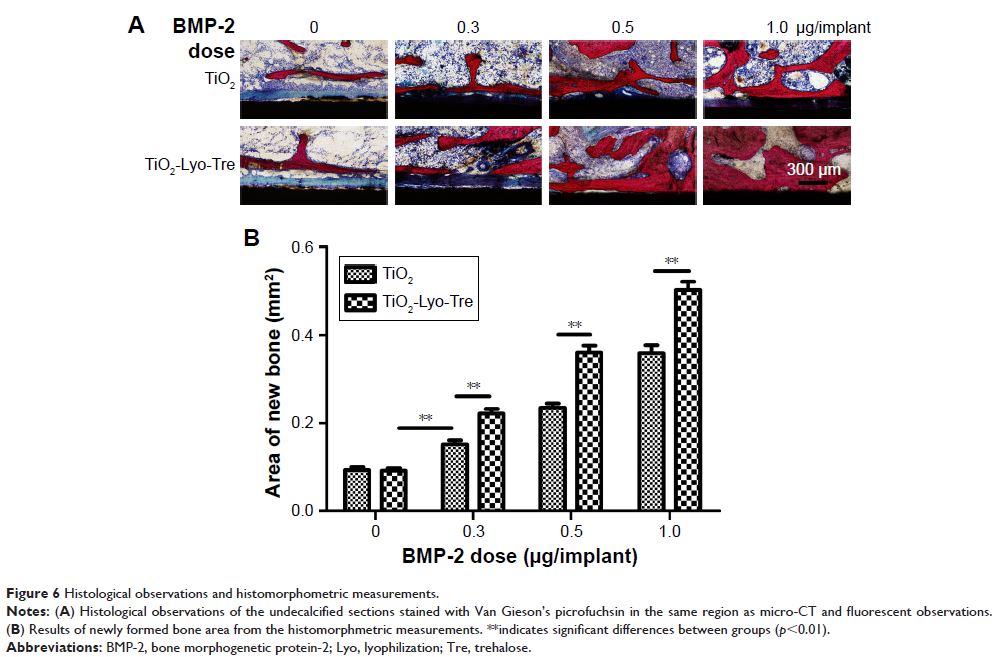108985
论文已发表
注册即可获取德孚的最新动态
IF 收录期刊
- 3.4 Breast Cancer (Dove Med Press)
- 3.2 Clin Epidemiol
- 2.6 Cancer Manag Res
- 2.9 Infect Drug Resist
- 3.7 Clin Interv Aging
- 5.1 Drug Des Dev Ther
- 3.1 Int J Chronic Obstr
- 6.6 Int J Nanomed
- 2.6 Int J Women's Health
- 2.9 Neuropsych Dis Treat
- 2.8 OncoTargets Ther
- 2.0 Patient Prefer Adher
- 2.2 Ther Clin Risk Manag
- 2.5 J Pain Res
- 3.0 Diabet Metab Synd Ob
- 3.2 Psychol Res Behav Ma
- 3.4 Nat Sci Sleep
- 1.8 Pharmgenomics Pers Med
- 2.0 Risk Manag Healthc Policy
- 4.1 J Inflamm Res
- 2.0 Int J Gen Med
- 3.4 J Hepatocell Carcinoma
- 3.0 J Asthma Allergy
- 2.2 Clin Cosmet Investig Dermatol
- 2.4 J Multidiscip Healthc

使用海藻糖作为冻干剂的递送系统减少用于骨再生的骨形态发生蛋白2的剂量
Authors Zhang X, Yu Q, Wang YA, Zhao J
Received 5 September 2017
Accepted for publication 8 December 2017
Published 12 January 2018 Volume 2018:13 Pages 403—414
DOI https://doi.org/10.2147/IJN.S150875
Checked for plagiarism Yes
Review by Single-blind
Peer reviewers approved by Dr Govarthanan Muthusamy
Peer reviewer comments 2
Editor who approved publication: Dr Linlin Sun
Introduction: To induce sufficient new bone formation, high doses of bone
morphogenetic protein-2 (BMP-2) are applied in regenerative medicine that often
induce serious side effects. Therefore, improved treatment strategies are
required. Here, we investigate whether the delivery of BMP-2 lyophilized in the
presence of trehalose reduced the dose of BMP-2 required for bone
regeneration.
Materials and
methods: A new growth factor delivery system
was fabricated using BMP-2-loaded TiO2 nanotubes by lyophilization with trehalose (TiO2-Lyo-Tre-BMP-2). We measured BMP-2 release characteristics, bioactivity,
and stability, and determined the effects on the osteogenic differentiation of
bone marrow stromal cells in vitro. Additionally, we evaluated the ability of
this formulation to regenerate new bone around implants in rat femur defects by
micro-computed tomography (micro-CT), sequential fluorescent labelling, and
histological analysis.
Results: Compared with absorbed BMP-2-loaded TiO2 nanotubes (TiO2-BMP-2), TiO2-Lyo-Tre-BMP-2 exhibited sustained release, consistent bioactivity, and
higher stability of BMP-2, and resulted in greater osteogenic differentiation
of BMSCs. Eight weeks post-operation, TiO2-Lyo-Tre-BMP-2 nanotubes, with various dosages of BMP-2, regenerated
larger amounts of new bone than TiO2-BMP-2 nanotubes.
Conclusion: Our findings indicate that delivery of BMP-2 lyophilized with
trehalose may be a promising method to reduce the dose of BMP-2 and avoid the
associated side effects.
Keywords: bone morphogenetic protein-2, dose reduction, delivery system,
trehalose, lyophilization, TiO2 nanotubes, BMP-2, regenerative medicine, surface modification
